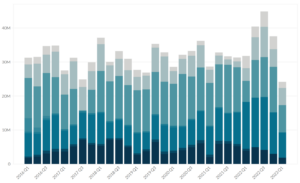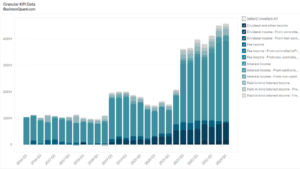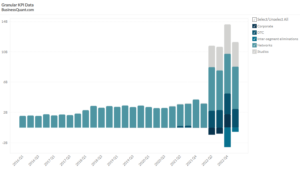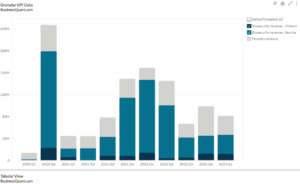
Cardinal Health’s Revenue Worldwide (2019-2023)
Exclusive Data
You need the Pro Plan to access KPI data
- Full access to the platform
- KPI data & segment financials on US stocks
- Financial data on thousands of stocks
- Download data in xlsx and csv formats
Pro Plan
$49 per month*
60% discount ends in:
.
About
More information
Subscribe to Pro or Enterprise plans to unlock this feature.
Contact the Analyst
Subscribe to Pro or Enterprise plans to unlock this feature.
Become a smarter investor today.
Access KPIs & Segment Financials on US stocks
This statistic highlights Cardinal Health’s Revenue Worldwide from Q1 2019 onwards, till the latest quarter, split across US and International, on a quarterly basis.
Cardinal Health’s Revenue Worldwide
| Revenue by Region | Q2 2021 | Q1 2022 | Q2 2022 | Contribution in Q1 2022 |
| United States | $40,360 | $42,841 | $44,382 | 97.63% |
| International | $1,186 | $1,130 | $1,078 | 2.37% |
| Total | $41,546 | $43,971 | $45,460 | 100% |
(All figures are in millions, except percentages)
Cardinal Health’s total revenue climbed from$41,546 million in Q2 2021 to $45,460 million in Q2 2022, representing a 9.42% year-over-year rise. It also increased by 3.38% in the most recent quarter, from $43,971 million in Q1 2021.
United States (US)
Cardinal Health has clinics in Brazil, Canada, and Puerto Rico in the United States.
Cardinal Health from the United States region showed an increment from $40,360 million in Q2 2021 to $44,382 million in Q2 2022, indicating an almost 10% growth on a year-on-year basis. It also increased by 3.59% in the latest quarter as compared to $42,841 million earned in Q4 2021. The majority of the revenue in the latest quarter, almost about 98% was contributed by this region.
International
In the International region, Cardinal Health is present in 30+ countries/regions, including China, India, Japan, Korea, the Philippines, Australia, Germany, Spain, and the United Kingdom.
Cardinal Health from the International region decreased from $1,186 million in Q2 2021 to $1,078 million in Q2 2022, indicating a fall of 9.10% on a year-on-year basis. It has shown a decline by 4.60% in the latest quarter as compared to $1,130 million earned in Q1 2021.
Impact of Covid-19
Cardinal Health relies on third parties to manufacture and distribute some of the items they promote and distribute. The processes are also reliant on third-party components, chemicals, raw materials, and energy. Many of these components, raw materials, and energy are purchased from a variety of sources across the globe, and certain items are sourced from a variety of countries. They buy certain components and raw materials from a single supplier in some cases for quality assurance, economic effectiveness, or availability.
Supplier ties could be disrupted, become less beneficial to the company, or be terminated, resulting in interruptions or insufficient supplies of these components, compounds, raw materials, or finished goods. Natural disasters, supplier facility closures, defective raw materials, the impact of epidemics or pandemics, such as COVID-19, and actions by US or international governments, such as export restrictions or tariffs, could all cause supply interruptions or other disruptions in manufacturing processes.
Insights to Maximize Market Opportunity
Analyzes point-of-care claims/remittances from over 1,300 oncologists in community oncology practices. Information is provided down to the 5-digit zip code level.
Analyzes point-of-care claims/remittances from over 2,300 oncologists in community oncology practices. Information is provided down to the individual physician level.
Analyzes payer claims for millions of cancer patients, including oral, IV, and injectable medicines, as well as labs from both inpatient and outpatient settings.
About the Company
Robert D. Walter launched Cardinal Foods in 1971 as a food wholesaler. After acquiring the Bailey Drug Company in 1979, it began wholesaling pharmaceuticals. In 1983, the business went public on the NASDAQ stock exchange by it’s ticker name “CAH”. After changing its name in 1994, Cardinal Health became the third-largest pharmaceutical wholesaler in the United States.
Cardinal Health is a global healthcare service and product provider serving hospitals, healthcare systems, pharmacies, ambulatory surgery centers, clinical laboratories, physician offices, and patients at home. It sells medications and medical supplies, as well as supply chain solutions that are cost-effective. For better patient management, and integrated care coordination, they connect patients, providers, payers, pharmacists, and manufacturers.
Medical and surgical products, such as gloves, surgical clothing, and fluid management equipment, are also manufactured by the company. It also runs one of the largest radiopharmacies networks in the United States. Over 75% of hospitals in the United States rely on Cardinal Health for medical supplies.
Did you like Cardinal Health’s Revenue Worldwide statistic?
Access more such KPI data points and segment financials on thousands of US stocks, with Business Quant.
You can get started here.
More data on US Stocks

Our Plans
Always know what you’ll pay. No hidden costs or surprises.
- Annual
- Monthly
60% discount till April 30
Pro
For serious investing
-
Company KPI data Access segment financials, non-GAAP metrics and KPI data from presentations and filings. Examples include financials by segment / region / product category, AT&T's broadband subscriber trends, Tesla's deliveries by model and lots more.
-
Stock research tools Features include : stock screener, stock comparison, industry financials, stock warnings, advanced charting tools, timeseries tables, scatter charts, financial statements, stock reports, SEC filings, stock ratings, institutional and insider ownership data. There are 200+ financial items and ratios on thousands of US stocks.
-
Industry data & tools Access premium operating data on 40+ industries. Examples include market share, smartphone shipments by vendor, subscribers by wireless carrier, historical gold production. There are 20,000+ such statistics.
Enterprise
For tailored workflows
-
All of Pro plan Get unfettered access to all our dashboards and dossiers.
-
Custom built features Get tailored dashboards built specially for you , based on your set of requirements, to simplify your research workflow.
-
Admin billing Back-end documentation support and multi-seat licensing.
* Billed annually, local taxes extra.
60% discount on Annual plan
Pro
For serious investing
-
Company KPI data Access segment financials, non-GAAP metrics and KPI data from presentations and filings. Examples include financials by segment / region / product category, AT&T's broadband subscriber trends, Tesla's deliveries by model and lots more.
-
Stock research tools Features include : stock screener, stock comparison, industry financials, stock warnings, advanced charting tools, timeseries tables, scatter charts, financial statements, stock reports, SEC filings, stock ratings, institutional and insider ownership data. There are 200+ financial items and ratios on thousands of US stocks.
-
Industry data & tools Access premium operating data on 40+ industries. Examples include market share, smartphone shipments by vendor, subscribers by wireless carrier, historical gold production. There are 20,000+ such statistics.
Enterprise
For tailored workflows
-
All of Pro plan Get unfettered access to all our features.
-
Custom built features Get tailored dashboards built specially for you , based on your set of requirements, to simplify your research workflow.
-
Admin billing Back-end documentation support and multi-seat licensing.
* Local taxes extra.






